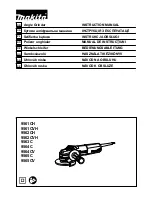
37
f) Practical
Á
ight tips for the
À
rst start
Although the model can be
À
own in a very con
¿
ned space, we recommend using an unobstructed space of approx.
3 x 3 m for the
¿
rst
À
ight attempts.
The surface should be smooth (tiles, parquet, etc.), so that you can see just before taking off whether the model wants
to rotate in a particular direction.
Position yourself directly behind the helicopter. This ensures that the model reacts to remote control commands (right,
left, forwards and backwards) exactly as you see them. However, if you face the cockpit of your model, in the lateral
control mode the model will respond from your perspective exactly the opposite as you steer the transmitter.
Important!
If the rotors hit any objects and become blocked or if the model overturns, turn off the rotor drive motors
immediately. To do this, immediately move the joystick for the pitch function to the lowest position.
If the model is stable during the
À
ight, do not move the joystick for the pitch function abruptly to the lowest position. In
this case, the helicopter would fall to the ground without propulsion and thus possibly sustain damage.
Never try to grab the
À
ying helicopter with your hand. There is a high risk of injury!
To prevent the helicopter battery from deep discharging, land the helicopter when the LED on the helicopter starts
to
À
ash.
Allow the helicopter rechargeable battery in the model helicopter suf
¿
cient time to cool down before recharging the
rechargeable battery.
g) Starting the model helicopter
Standing behind the ready-to-start model helicopter, push the joystick for the pitch function (see Fig. 1, no. 8) slowly
and sensitively from the lowest position to the top.
When the rotors start up, quickly move the joystick for the pitch function to the middle position.
The model helicopter will then take off and, if correctly adjusted, go into straight forward
À
ight. The model helicopter
will change its
À
ight altitude depending on the position of the joystick for the pitch function (see also Fig. 9).
Use the joystick for the tail function (see Fig. 1, no. 4) to specify the
À
ight direction and thus perform the desired
curves and circles.
Practical
tips:
The model helicopter is factory set a little bit top heavy. Therefore, it goes into the slow forward
À
ight auto-
matically after takeoff. Thus, the two channels are absolutely suf
¿
cient for control.
The
forward
À
ight speed can be customised by attaching small weights to the tip of the fuselage or tail.








































